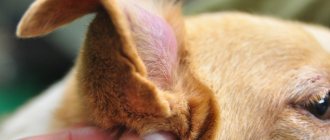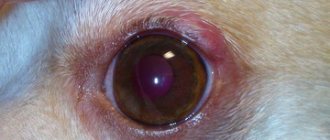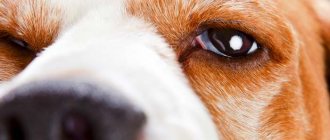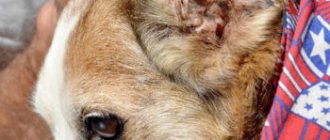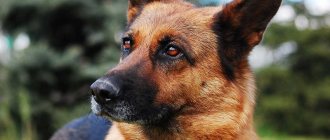Often, while stroking the dog, the owner discovers a lump on its body and immediately begins to panic, suspecting that the pet has a dangerous disease. Of course, fears may not be groundless.
It is likely that the lump under the skin has a cancerous etiology, but you should not sound the alarm without showing the animal to the veterinarian, because neoplasms may be harmless and may not even require treatment.
Causes of the disease
Lumps under the skin in different parts of the body can have different origins - a bee sting, a malignant or benign neoplasm, an abscess, etc. Some swellings go away after a couple of days, others increase in size over time and begin to cause serious discomfort to the pet.
The main reasons for the appearance of bumps on a dog’s body are:
- injury;
- viral infection;
- damage to blood vessels after surgery;
- oncology;
- penetration of bacteria.
If the subcutaneous lump does not go away after two days and bothers the animal, contact a veterinary clinic.
Risk factors
The most commonly diagnosed condition is elbow bursitis in dogs. The following factors can contribute to the development of inflammation in the bursa:
- injuries of various etiologies in the area of the synovial bursa;
- intense loads on the musculoskeletal system;
- concomitant joint pathologies;
- impaired metabolism;
- incorrect content.
The acute infected form is usually the result of a wound, hematoma or abrasion in the elbow joint. Often the pathology is caused by Staphylococcus aureus in dogs, which has penetrated into the tissue through the wound surface.
Young dogs are more susceptible to the disease; adult dogs develop a so-called callus on the elbows.
Autoimmune pathologies, including rheumatoid arthritis, can also contribute to the development of bursitis. In this case, the animal experiences an ossifying form, in which salts are deposited in the synovial bursa.
Fluid accumulation in the bursa is often observed after surgical treatment of joint dysplasia in dogs and other pathologies of the musculoskeletal system.
Bursitis often occurs in service and guard animals that are kept in unsuitable conditions. When a dog regularly lies on a hard surface without bedding, degenerative changes in the elbow area develop as a result of constant pressure.
Main symptoms
There is no single clinical picture for bumps on a dog’s body, since they can be caused by different diseases, each of which has its own characteristic signs.
So, with an abscess that occurs under the influence of a bacterial infection that enters the body through a bite, puncture wound or scratch, the dog experiences swelling, fever, and pain. The lump swells for several days, after which it begins to fester.
Smooth-haired dogs often develop papillomas and warts on their bodies. The cause of their occurrence is considered to be a viral infection. The growths on the skin are usually brown in color and are painless, but it is still worth consulting a veterinarian.
The dog may develop a hematoma as a result of bruises or fluid accumulation when blood vessels are damaged during surgery. It is a formation that changes the shape of the part of the body where it is located. It does not cause discomfort to the dog, however, if the hematoma does not go away for a long time, consultation with a specialist will also be required.
A cyst can appear anywhere: both on the body and on the dog’s face, for example, at the junction of the jaws. Upon inspection, it is quite easy to detect. It appears as reddish, painful abscesses that the dog tries to lick.
Pyoderma is a purulent inflammation of the skin in dogs, which is accompanied by a rash and papules. Swellings can form all over the body, paws, in folds of skin, and on the face.
Insect bites (bees, ticks and even mosquitoes) can cause painful swelling. The most dangerous bites are to the face and mouth.
There are two types of tumors in dogs: benign and malignant. Benign tumors grow slowly and, as a rule, do not cause discomfort to the dog. Unlike malignant tumors, they do not metastasize. However, this does not mean that they do not pose a danger to the health of the animal, since over time they can degenerate into cancer.
Malignant tumors appear as a result of cell mutation. Cancerous tumors are characterized by rapid growth, absence of symptoms at the initial stage, and metastases. Sometimes the bumps break through the skin and bleed. As the disease progresses, an increase in symptoms is observed.
Diagnostics by appearance
Important details:
- The size of bumps on a dog’s paw varies from a few millimeters to 3–5 cm or more. Many pet owners think: the more actively the tumor grows, the higher the likelihood of cancer. This statement is not always true. It often turns out that a large tumor is practically harmless, and several small subcutaneous formations are malignant.
- Without a comprehensive diagnosis, it is impossible to accurately determine the nature of the skin lesion and the degree of risk to the animal’s body. In case of traumatic tissue damage or the development of an abscess with active suppuration, it is easier to understand the reason for the formation of an unesthetic lump on the paw, but a medium-sized lump can be both malignant and relatively harmless.
- An abscess can be superficial or deep. In the absence of timely treatment or the use of ineffective ointments, the inflammatory process can reach the bone, which leads to severe pain in the dog, damage to hard tissues, and lameness. If suppuration develops in the area of the perianal glands, and the owner does not go to the veterinarian, hoping for home treatment, then the infection can spread to the internal organs or go lower, affecting the entire surface of the paws, which is very dangerous.
- One of the signs of the possible development of a cancerous tumor is the fusion of a lump with the skin. On palpation, the compaction cannot be moved from its place; the swelling does not roll under the fingers like a ball. If this symptom is detected, you should urgently take the animal to the veterinarian.
- Pain in the palpation area does not always indicate the malignant nature of the process. In many cases, the early stage of oncological pathology does not cause discomfort in the dog, but with inflammation of the subcutaneous tissue, palpation leads to painful sensations.
Warning! You cannot independently diagnose and determine the degree of danger of a lump on a pet’s paw. A small tumor can cause more harm to a dog’s health than a large tumor. The sooner the owner takes the animal to the veterinarian, the lower the risk of complications for any form of the disease.
Diagnostics in a veterinary clinic
To make a correct diagnosis of a dog, a veterinarian will need to examine the animal and do a number of necessary diagnostic tests, including:
- general and biochemical blood tests;
- Analysis of urine;
- Ultrasound;
- biopsy for histological examination of tissue;
- fingerprint smear - to determine cell atypia or the presence of an infectious agent;
- computed tomography - if a malignant tumor is suspected;
- radiography - to determine the depth of penetration of the lump into the soft tissue.
According to indications, additional diagnostic methods can be used to obtain more complete information.
Symptoms of tumor appearance
If we talk about acute bursitis, its main symptoms are: swelling in the bend of the joint, this swelling is hotter to the touch than the rest of the animal’s body;
- severe pain when moving, the dog may whine and lean more
- on healthy paws, squeezing the sick one;
- severe pain is felt at night;
- lameness, sometimes the animal tries to move less;
- Sometimes a purulent formation may form in the swelling. The cone becomes very dark.
By quickly identifying bursitis in a dog, you can prevent the disease from becoming chronic, thereby relieving pain symptoms and removing swelling in the joints. False (or chronic) bursitis is a form of disease in which a lump or swelling appears on the dog’s joints, but does not cause him any pain and does not make it difficult for him to move.
Who is affected by bursitis?
Bursitis is a common disease in large breed dogs. Small Chihuahuas, Yorkshire Terriers, and Pekingese usually do not suffer from this disease, since the structure of their joints is slightly different.
Large dogs, especially service dogs that spend a lot of time doing physical activity, are more likely to suffer from bursitis. At the age of 6-7 years, such dogs may be slightly lame on one or two hind legs. Since the disease progresses quite quickly, the dog’s limbs may fail within a couple of weeks. In such cases, treatment and hospitalization do not help. Therefore, veterinarians so strictly recommend monitoring the animal’s activity.
Treatment method and prognosis
After making a diagnosis, the doctor develops a treatment regimen. For each individual case, it will be individual depending on the disease, the severity of the animal’s condition, age, and tolerance (intolerance) to medications.
For cancerous tumors, drug treatment is not effective, since no drug can stop the development of the tumor. Radiation therapy, chemotherapy, and surgery to remove the tumor are indicated. After surgery, the course of chemoradiotherapy is repeated.
Benign tumors are removed surgically.
Treatment of abscess is also surgical. The inflamed area is opened, the open wound is washed, and Levomekol ointment is injected through the installed drainages.
The prognosis depends on the diagnosis. In most cases it is favorable, with the exception of malignant tumors. Cancer responds well to treatment if you contact a specialist in the initial stages of the disease. So, at stages 0, I, cancer is curable by 90%, at stages III, IV - by 50%.
Non-cancerous and oncological types of bumps in dogs
A lump in a dog that is not associated with cancer can appear for various reasons:
- injuries;
- vascular damage during surgery;
- mechanical damage to the skin;
- inflammation of the sebaceous glands;
- changes in hair follicles;
- viral infections.
Tumors can appear under the skin, then they are clearly visible. Sometimes formations grow in soft tissues and palpation is required to detect them. All non-cancerous formations can be treated well, the main thing is to show the animal to the veterinarian in time.
“What dog owners need to know about cancer”
In this video, experts will talk about cancer in dogs.
Cancerous
Because of the fur, it is not always easy to notice a tumor, so you need to carefully examine the skin when bathing and combing. Cancerous tumors grow at the expense of the animal's body. Their structure is changed cells, continuously multiplying and promoting tissue growth.
There are breeds in which the risk of cancer is quite high:
- boxers;
- retrievers;
- Great Danes;
- Terriers.
The main symptoms include bumps, sometimes with an ulcerated surface. There are other auxiliary signs by which one can suspect the disease: the dog loses its appetite and is inactive.
If the tumor grows quickly, the animal's gait changes, swallowing becomes difficult, bleeding is possible, and an unpleasant odor from the area with the lump is possible.
Benign tumors
Benign tumors can appear in dogs at any age. They are characterized by slow growth and the absence of obvious symptoms in the first stages. The reasons, like in humans, are varied and not fully understood. The animal rarely experiences discomfort until the bumps reach a significant size. Sometimes breakthrough and external bleeding are possible.
Malignant tumors
Unfortunately, cancer in four-legged pets is quite common. The nodes have a poor quality course and pose a danger to health and life. They can develop up to several years, or they can grow actively and quickly. They quickly affect nearby organs and spread metastases through the bloodstream throughout the body.
Sarcomas form in old animals, fibrosarcomas affect young animals up to 6 months. In advanced cases, the skin becomes thinner and damaged, and external bleeding occurs. Skin and breast cancer can be detected with the naked eye. They are characterized by a palpable formation of varying density.
Insect bites
A curious pet cannot avoid the bites of various insects - ants, hornets, spiders, hymenoptera insects. Smooth-haired breeds are most often affected.
If a dog is bitten by a bee or wasp, swelling and redness will occur at the site. The animal feels severe itching and tries to scratch the swollen area with its paws. Bites occur in areas such as paws, fingers, ears, mouth, eyes.
What to do if detected
When you see a lump on your dog’s skin, you need to carefully examine it and carefully palpate it. If there is pain, you should immediately show your pet to a specialist, since the pathology can be dangerous due to suppuration, spread of infection, and malignancy.
A visit to the veterinarian cannot be postponed. Special tests may be needed to confirm the diagnosis:
- tomography;
- biopsy;
- X-ray examination;
- smear;
- radiography.
Only after this the treatment tactics are determined. Depending on the pathology, these may be conservative methods or surgical intervention. Under no circumstances allow your dog to chew, scratch, or lick the bump. Because of this, there may be granulomas, infection, and bleeding.
Take care of your pets, examine, stroke, feel. With enough attention, you can always detect any disease in the early stages and consult a specialist in time. Timely treatment will help avoid unpleasant consequences.

